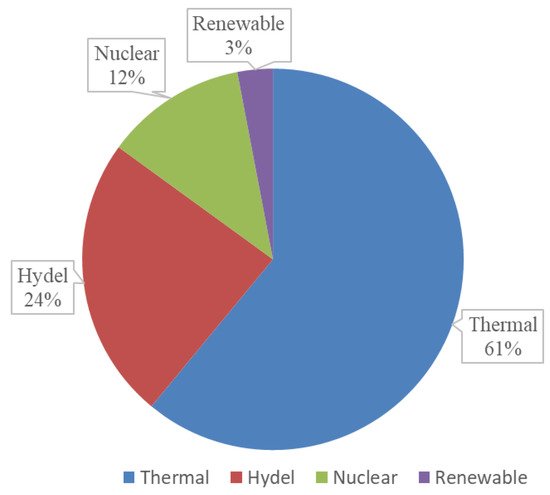You're using an outdated browser. Please upgrade to a modern browser for the best experience.

Submitted Successfully!
Thank you for your contribution! You can also upload a video entry or images related to this topic.
For video creation, please contact our Academic Video Service.
| Version | Summary | Created by | Modification | Content Size | Created at | Operation |
|---|---|---|---|---|---|---|
| 1 | Zulfiqar Ali | -- | 4364 | 2022-10-11 08:08:44 | | | |
| 2 | Sirius Huang | Meta information modification | 4364 | 2022-10-12 03:47:25 | | |
Video Upload Options
We provide professional Academic Video Service to translate complex research into visually appealing presentations. Would you like to try it?
Cite
If you have any further questions, please contact Encyclopedia Editorial Office.
Abbas, S.Z.; Ali, Z.; Mahmood, A.; Haider, S.Q.; Kousar, A.; Razzaq, S.; Hassan, T.U.; Su, C. Energy Scenario and New Energy Policies in Pakistan. Encyclopedia. Available online: https://encyclopedia.pub/entry/28815 (accessed on 25 December 2025).
Abbas SZ, Ali Z, Mahmood A, Haider SQ, Kousar A, Razzaq S, et al. Energy Scenario and New Energy Policies in Pakistan. Encyclopedia. Available at: https://encyclopedia.pub/entry/28815. Accessed December 25, 2025.
Abbas, Syed Zagam, Zulfiqar Ali, Anzar Mahmood, Syed Quosain Haider, Anila Kousar, Sohail Razzaq, Tehzeeb Ul Hassan, Chun-Lien Su. "Energy Scenario and New Energy Policies in Pakistan" Encyclopedia, https://encyclopedia.pub/entry/28815 (accessed December 25, 2025).
Abbas, S.Z., Ali, Z., Mahmood, A., Haider, S.Q., Kousar, A., Razzaq, S., Hassan, T.U., & Su, C. (2022, October 11). Energy Scenario and New Energy Policies in Pakistan. In Encyclopedia. https://encyclopedia.pub/entry/28815
Abbas, Syed Zagam, et al. "Energy Scenario and New Energy Policies in Pakistan." Encyclopedia. Web. 11 October, 2022.
Copy Citation
Smart grid plays a vital role in energy management systems. It helps to mitigate the demand side management of electricity by managing the microgrid. Pakistan being an energy deficient country has introduced some new policies such as Energy Wheeling Policy (EWP), Energy Import Policy (EIP), and Net Metering/Distributed Generation Policy (NMP) to manage the electricity demand effectively. In addition, the Energy Efficiency and Conservation Act (EECA) has also been introduced.
energy wheeling policy
energy import policy
energy efficiency
hybrid microgrid
net metering policy
smart grid and conservation
1. Introduction
Energy management has been a crucial task ever since. It is a significant and fundamental research focus because of its associated environmental and sustainability concerns [1][2]. Energy management is an effective way of optimizing the power system assets comprising generation, distribution, and utilization. However, energy demand in the world has drastically increased over the last decade and is expected to peak by 2025, World Energy Council says [3]. The current global trend regarding the energy sector is primarily focused on energy management by introducing new policies and methodologies to maintain and stabilize energy demand and address environmental concerns like global warming and climate change etc. [4][5].
Pakistan is an energy-deficient and developing country of over 207.774 million people [6][7]. The country has been facing energy scarcity for a long [7][8]. Pakistan has an average peak demand of 22,000 MW with a shortfall of 5000 MW [9]. The annual energy demand growth rate is 10% which shows that the average demand will rise to 45,000 MW by 2030 [9]. The government of Pakistan has taken initiatives and introduced various policies to manage the growing energy demand [10]. The following sections elaborate on the current energy scenario, hybrid microgrid management and new energy policies including EWP, EIP, NMP, and EECA as follows.
2. Current Energy Highlights of Pakistan
South Asian countries such as Bangladesh, India, and Pakistan are the most diversified areas in sense of geological, geographical, topographical, and meteorological points of view. However, the total energy demand in these areas is very high because of densely populated areas of the world [1]. To understand the relation between existing supply and demand, consider the following statistics which provide an intuitive analysis of Pakistan about the electricity generation during the last few years as depicted in Table 1.
However, the generation demand for electricity in Pakistan in 2015-16 is about 18–23 thousand MW [11] and is achieved mostly by thermal followed by hydel, nuclear, and renewable sources, respectively, which is shown in Figure 1. Although with the growing population and advanced industry, electricity demand has been increasing at a rate of 10% per year, it is necessary to work on new innovative ideas to generate electricity accordingly to meet the demand.
| Electricity Generation for July–March 2008-18 | |||||||||
|---|---|---|---|---|---|---|---|---|---|
| Installed Capacity (MW) | Generation (GWh) | Hydel | Thermal | Nuclear | Imported (GWh) | ||||
| Installed Capacity (MW) | Generation (GWh) | Installed Capacity (MW) | Generation (GWh) | Installed Capacity (MW) | Generation (GWh) | ||||
| July–March | |||||||||
| 2008-09 | 19,575 | 60,793 | 6481 | 20,526 | 12,632 | 39,154 | 462 | 918 | 195 |
| 2009-10 | 19,650 | 63,178 | 6481 | 21,671 | 12,707 | 39,342 | 462 | 2521 | 185 |
| 2010-11 | 20,729 | 68,970 | 6481 | 23,817 | 13,785 | 42,664 | 462 | 2260 | 229 |
| 2011-12 | 22,578 | 66,130 | 6557 | 22,044 | 15,234 | 39,940 | 787 | 4146 | ... |
| 2012-13 | 22,851 | 66,962 | 6650 | 20,536 | 15,414 | 43,125 | 787 | 3301 | ... |
| 2013-14 | 23,048 | 73,435 | 6858 | 23,953 | 15,440 | 44,847 | 750 | 4331 | 304 |
| 2014-15 | 23,212 | 71,712 | 7027 | 23,478 | 15,435 | 43,611 | 750 | 4273 | 350 |
| 2015-16 | 23,101 | 73,209 | 7027 | 24,544 | 15,324 | 45,252 | 750 | 3078 | 335 |
| July–February | |||||||||
| 2016-17 * | 22,600 | 68,592 | 7097 | 21.862 | 13,514 | 42,545 | 1005 | 3082 | 315 |
| 2017-18 | 29,573 | 69,956 | 7248 | 18,858 | 19,816 | 19,816 | 1321 | 5236 | 322 |
* Electricity generation from Renewable sources remained at 1102 GWh and 1377 GWh against 984 MW and 1188 MW installed capacity for the periods 2016–17 and 2017–18, respectively.
Electricity generation from RES has been quite insignificant in Pakistan; nevertheless, the ice has been broken, and RES is expected to flourish in near future. Figure 2a,b overviews the potential of RES mainly solar and wind energy and various RES projects installed in Pakistan, respectively [12].
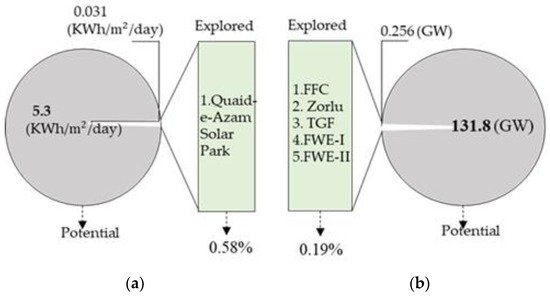
Before discussing the NMP in detail, one need to make a precise analysis of available RES in Pakistan. Biomass, wind, and solar have appeared as the most feasible energy sources in the country.
Pakistan is immensely rich in solar energy around the year with an average of 5.3 kWh/m2/day [1]. According to a scientific assumption, solar power harvesting is possible if the sun shines approximately 165 days in a year while Pakistan gets twice the sunshine than the threshold [17]. However, wind energy is another feasible and economical source to harness for electricity generation. Pakistan has two large wind corridors, which are the wind corridor in Sindh coastal areas and the wind corridor in Baluchistan coastal areas [18]. These two wind corridors have the potential of 50,000 MW [19] with 131,800 MW overall potential in the country [1]. Pakistan’s electricity consumption share is shown in Figure 3, which illustrates that the maximum share is in domestic followed by industrial, agricultural, commercial, street lights, and other government loads, respectively [18].
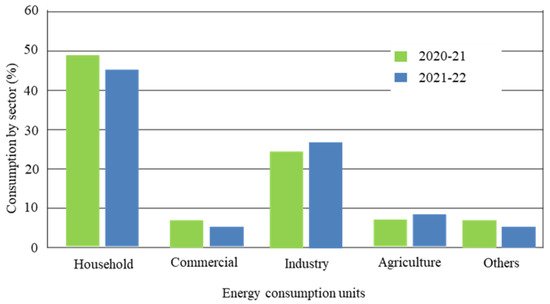
Figure 3. Sector Wise Share of Electricity Consumption in Pakistan, Source: Pakistan Economy survey 2021–22 [20].
The energy consumption share in different sectors in Pakistan shows that maximum electricity is consumed in the domestic followed by industrial and agricultural sectors, respectively. The per capita energy consumption has increased over decades in the manner shown in Figure 4. Also, it shows per capita consumption by 2010 has increased three folds compared to that in the 1970s. This increase in per capita energy is associated with the increase in the country’s population and its industrial ventures [21]. Due to these issues, the electricity deficit increased, and the energy crisis rose with time as shown in Figure 5.
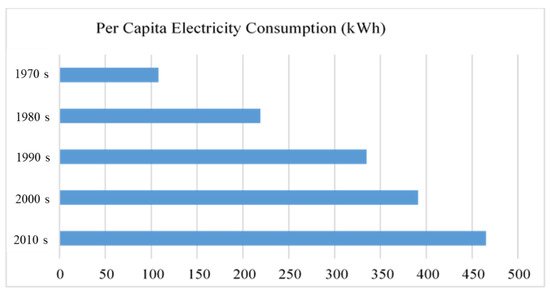
Figure 4. Decade Wise Comparison of Electricity Consumption per Capita (KWh). Data Sources: Pakistan Economic Survey 2009-10 & World Bank.
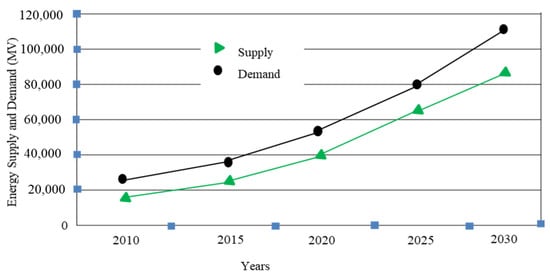
Figure 5. Supply and Demand of Pakistan: 2010–2030 [22].
3. Hybrid Microgrid Management
The integration of RES as distributed generation is a desirable response to the reliance on fossil fuels, the steadily rising energy demand, and the inferior energy quality delivered by an old and inefficient power network (DG) [23]. Numerous analyses have been conducted that examine various facets of these networks, including control methods, global test locations, plans for optimization, software tools accessible, security measures, etc. With the use of microgrids, it is possible to integrate RES, ESS, and loads into a single grid. The designs of microgrids can be ac, dc, or hybrid ac/dc; however, in recent years, hybrid systems (Figure 6) have begun to be seen as an appealing choice since they incorporate the most important components of both ac and dc networks. Because most research focuses on ac- or dc-based microgrids individually, a more detailed analysis of the characteristics relevant to hybrid microgrids is required [24][25].

Figure 6. The Topology of Hybrid Microgrid System.
Hybrid microgrids consist of an ac network, a dc network, and an interface that controls the power flow between the networks and the utility grid as depicted in Figure 6 [26][27]. The capacity to connect ac- and dc-based equipment to the grid without using as many interface converters is only one advantage of these configurations. However, their control strategy must incorporate the following elements: Stability of voltage and frequency at grid-tied and islanded modes of operation, adequate power sharing of RES and ESS units, and optimal power exchange between the microgrid and the power network.
Even though there are several control techniques listed in the literature, only a handful of them specifically targets hybrid ac/dc microgrids. Additionally, there have not been many assessments of hybrid microgrid techniques, and the data that is given is a bit contradictory. Therefore, the major goal of this research is to identify and evaluate the most significant control mechanisms that hybrid microgrids may use [28][29]. When modified, several of them might be beneficial for hybrid microgrids as well as standalone ac and dc microgrids. Researchers and developers will be helped in choosing the best management strategy based on the needs of their company by the classification and analysis of the key aspects of the control strategy.
The Hybrid microgrid systems management has a great importance owing to manage the energy generation and consumption of countries especially in the developing states. In developing states, the governments do not have enough resources to construct new major generation plants. However, the citizens that have capacity of individual generation can contribute to the national grid, which can only be possible by managing the renewable energy such as Solar Hybrid microgrids [30].
Control Strategy Overview of Hybrid Microgrids
The control technique used to manage the network’s connected devices is one of the most distinguishing characteristics that set microgrids apart from traditional distribution grids. This approach is essential for the best management since microgrids are distributed [31][32]. To provide a reliable and constant power supply, it is crucial to deploy ESS devices to effectively control the intermittent behavior of DG units. When used in an autonomous mode, the microgrid also has to be properly maintained to guarantee consistent voltage and frequency and provide a smooth transition in operating mode [33][34][35]. These restrictions make control systems for microgrids a difficult subject that has drawn a lot of research.
In the microgrid context, the following requirements are typically required for a control strategy:
-
Stability: it is the control of the microgrid’s voltage and frequency while it is operating in a variety of modes. Additionally, it guarantees a stable and dependable power network on both the ac and dc sides of the microgrid [36];
-
Protection: it includes managing grid faults, monitoring energy flow, and keeping an eye on vital components;
-
Power balancing: optimum load sharing and synchronized DG supply;
-
Transition: transitioning without interruption from one microgrid operation mode to another, such as from islanding to grid-tied mode or vice versa;
-
Power transmission: it is the process of moving electricity from the utility grid to the microgrid;
-
Synchronization: For the best power transmission, the microgrid and the power network must be synchronized;
-
Optimization: it is the management of systems based on the microgrid and utility grid circumstances (such as market scenario, power demand/supply, or energy projection), to lower costs, enhance the energy efficiency, etc. [37].
These components need the creation of a more intricate control architecture as compared to the controls included in typical distribution networks. Storage units in a normal electricity grid are not managed by the grid operator unless their scale is typical for the network [22].
The most common control techniques are difficult to classify since they mostly depend on the characteristics of the microgrid. The majority of authors suggest applying hierarchical control strategies to accomplish the aforementioned objectives. This method distinguishes between local/primary control, microgrid/secondary control, and global/tertiary control as the three basic control levels [38][39]. Each level is responsible for the control of the microgrid at a different scale and their main functions are summarized in Figure 7.

Figure 7. The Key features of control levels of a hierarchical Control strategy.
The classification of the most important hierarchical control level strategies is shown in Figure 8. The categorization was made using the studies mentioned in the literature, and each attribute is discussed in more detail in the sections that follow.

Figure 8. The categorization of primary, secondary and tertiary control levels.
4. Introduction of the National Electric Power Regulatory Authority
National Electric Power Regulatory Authority (NEPRA) is an independent organization in Pakistan which primarily regulates electric power issues with the assurance of no extraneous influence. The need for its establishment was first presented in Water and Power Development Authority’s (WAPDA) strategic plan in 1992. The strategic plan proposed privatization of the power sector with its success lies in the creation of an autonomous body. In this context, the authority was established in 1995 by a Presidential Ordinance, however, formal notification was made in the Regulation of Generation, Transmission and Distribution of Electric Power Act, 1997 [40]. The primary aim behind its establishment was to provide a conducive environment for investors and to promote private power production in the country. Furthermore, its responsibilities include the issuance of licenses and tariff determination for three pillars of the power sector (Generation, Transmission and Distribution), ensuring high quality and safety of operation and granting financial approvals & power acquisition to utilities. NEPRA has a serious challenge of proving its autonomy and impartiality in the context of strong political influence seen by many government departments. NEPRA is the key authority which constructs these policies for Pakistan for its energy management meticulously and moving one step towards smart grid via these recommended energy policies [40].
5. Wheeling of Electric Power, 2016
Wheeling of Electric Power was first devised in 2016 when NEPRA added some new regulations in the Electric Power Act, 1997, officially notified as, “National Electric Power Regulatory Authority (Wheeling of Electric Power) Regulations, 2016”. These regulations apply to Transmission Licensees/Distribution Companies (DISCOs) and the applicants who desire to acquire wheeling services. These regulations encourage the applicants by ensuring “non-discriminatory open access” to all services offered by the service providers. The regulations also allow Generation Company (GENCO) to construct its own dedicated Transmission/Distribution facility at its expense. However, the expenses incurred in this set-up could be recovered through the wheeling charges. Once constructed, the operation, maintenance and ownership of this dedicated system would be to the relevant Distribution Company. Details of the application process, requirements of the wheeling meter, banked energy, shortfall, overdrawing, and liquidated damages are also given in these regulations as shown in Figure 9 [40][41].
The EWP and NMP policies are the benchmark and milestones toward the advancement of the national grid. Mostly the major Bulk Power Consumers (BPCs) are situated in areas like Karachi, Faisalabad, Lahore and Multan, where the electricity is generated from thermal resources. As the BPCs require power in bulk amounts, it makes the electricity more expensive and prone to interrupts because of the load on the national grid at peak hours. As the Generation Companies near BPCs use thermal generation sources, the price per unit is higher as compared to hydel sources. Therefore, it is necessary to import electric power from the other GENCOs which have relatively inexpensive sources of generation such as far-apart hydel sources. For this purpose, the NEPRA introduced the EW policy [42] in 2016 under Pakistan’s Legislation.
This policy allows the BPCs to get the energy from any GENCO and opens the doors for a competitive environment for power purchase in the country. Transmission for this purpose is almost impossible for any individual BPC because of the large distances involved from GENCOs, particularly from the north of Pakistan which produce electric power from hydroelectric sources which are relatively inexpensive. To overcome this difficulty, BPCs can be benefitted from the current network of National Transmission and Dispatch Company (NTDC) and DISCOs for power transmission and distribution accepting the terms and conditions for this facility [43].
Under this policy, the BPC and the GENCO agree on a specific amount of energy. The subsidiary agreement between BPC and the DISCO/NTDC permits BPCs to use the existing transmission and distribution network. According to this agreement, the specific grid code is assigned for a specific grid path from GENCO to BPC through NTDC and DISCO under the consent of higher authority, i.e., NEPRA (2016) [44].
The wheeling meters are installed at the entrance and exit points of NTDC and DISCO for the calculation of the amount of in and out flow of electrical power. The transmission at 500 KV and 220 KV levels are handled by the NTDC [43] while the distribution at 132 KV and 11 KV levels are carried out by the respective DISCOs [45]. There are four GENCOs and nine DISCOs in Pakistan.
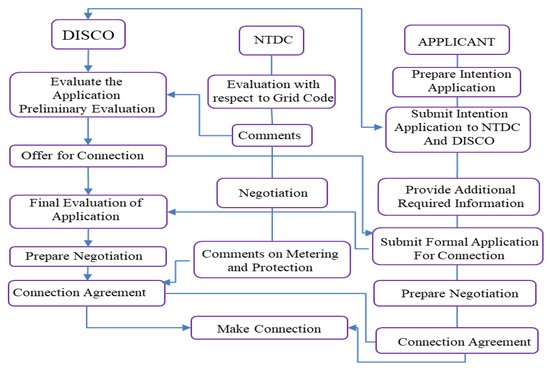
Figure 9. The Connection Agreement, Connection Agreement NEPRA Energy Wheeling Agreement (Schedule II) [46].
The BPC will be responsible to pay the generation cost (running cost) and the wheeling cost. The wheeling policy establishes mutual coordination link between DISCO and BPCs ensuring no load on a specific grid code by DISCO without prior consultation with the BPC otherwise strict action could be taken by BPC under the law. The Wheeling meters are sealed in presence of the representatives of both parties. In the case of maintenance, the representatives of both parties are present on site [47]. The BPC will be responsible to pay the generation cost and the wheeling cost. Due to the EW policy, the uninterrupted power supply is provided to the BPC which is essential for business activities. The EW policy ensures the provision of inexpensive energy to the BPCs. By introducing these types of new policies, the firms are encouraged to invest in businesses available in their area.
Applications and Challenges Associated with EW Policy
As for as, the concern of the economy of a country, the industry is considered its backbone. Energy is the primary mover for industrialization in the country. So, the country should have an adequate amount of energy generation capacity so that its industrial wheel would move smoothly. EW policy enables to ensure the uninterrupted supply of energy to the industrial sector. Pakistan is already investing a huge amount in the form of subsidies to provide cheap and uninterrupted energy to the industrial sector. It would result in sustainability in industrial growth by providing cheap energy wheeled through remote areas to BPCs. This is directly associated with the economic sustainability of the country.
Many issues and problems arise due to EW policy. These involve legislation, maintenance, tariff charges and power quality challenges. The power quality is mainly affected by losses in long-distance transmission. According to the policy, the power is to transmit over long distances through transmission and distribution networks, therefore, transmission losses such as copper losses etc. are expected to be increased. To prevent these losses the transmission and distribution companies should adopt modern techniques [48]. The transmission and distribution companies have assigned the predetermined tolerance value of power; in case of violation, a code of conduct applies to the stakeholders. The other power quality issues are harmonics due to switching and natural disasters. These harmonics can be controlled using modern digital meters [49].
6. Distributed Generation/Net Metering Policy, 2015
To increase energy in the national grid, new power plants must be constructed, and new energy conservation and management policies must be defined; one of these policies is NMP. NEPRA introduced distributed generation and net metering rules in 2015 as shown in Figure 10, called “National Electric Power Regulatory Authority (Alternative & Renewable Energy) Distributed Generation and Net Metering Regulations, 2015”. In addition to some general rules such as registration & application process, it also describes the mechanism of interconnection between DGs and DISCOs, facility design and protection requirements along with details of financial responsibilities. It also specifies permissible variation of ±1% and ±5% to the nominal frequency and voltage, respectively. According to these rules, a single meter or two separate meters should be installed to accomplish the net metering operation. However, the condition of accurate measurement is imposed in either case. Distributed Generators are also responsible to ensure all safety requirements to assure reliable operation of the system. The flow of billing follows the “as much produced as much earned” policy. If Distributed Generator consumes more kWh and supplies less to DISCO, then it would be charged by the DISCO and vice versa. Importantly DISCOs would pay off-peak rates of kWh for excess supply from distributed generators. They would also enjoy exemption from fuel price adjustment, fixed & peak time charges and duties/levies. Minor amendments to these regulations have been introduced in net metering amendments 2017.
This policy enables the users to become prosumers (power producers and consumers) and supplies the two-way flow of energy between the DISCOs and the consumers [48][50]. Prosumerism can only be achieved by distributed generation, i.e., generating own energy through RES and luckily Pakistan is rich in these resources as stated earlier [51]. The most important aspect of the connection between DISCOs and the national grid is the points where the energy consumed by the consumers from the national grid and the energy given to the national grid by consumers are monitored and compensated utilizing advanced smart meters [52]. At the end of the month, the tariff is finally calculated and formulated accordingly [53]. Furthermore, Net Metering can be implemented in different typologies including Net Metering, Aggregate Net Metering, and Virtual Net Metering [54]. However, when a community collectively generates energy from renewable resources and supplies it to the national grid through net metering is known as Community Net Metering and when any private firm or any other organization generates energy from renewables in aggregate form and supplies it to the national grid by mean of net metering is known as Aggregate Net Metering while if it produced virtually from any resource, like the parallel connection of the car batteries for time being, is known as Virtual Net Metering [55].
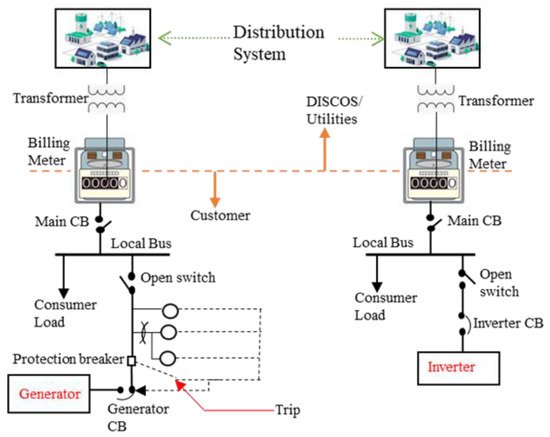
Figure 10. The Topology of distribution systems and Net Metering Concept draft [53].
NMP Issues and Recommendations
Despite the inception of NMP in 2015 by the NEPRA, it is still struggling for its effective implementation in the country due to some associated issues. The main issue is the synchronization of the power provided by consumers with the national grid. The distributed generation and the DISCOs have different frequencies, voltage levels, phase differences, phase angles and reactive power [56]. To attain synchronization, all characteristics should be the same; the quality of power and voltage level can be improved by providing reactive power to the system by adding capacitor banks as condensers. Among other issues, the most discouraging factor is the initial processing time consumed in the application approval. Standards defined by NEPRA in Net Metering Regulation 2015 for equipment compatibility are impractical and ambiguous especially since the provision of “other international standards” in the regulation has worsened the situation. The regulation also impedes the single-phase consumers from this opportunity, limited to the three-phase consumers only. The undefined interconnection charges, unskilled workers, lack of proper forum to facilitate the customers, safety issues, high initial installation cost, and efficiency and power quality issues of renewable energy generating equipment are some other aspects which are restricting the applicability of net metering. Application processing time based on the capacity of the system can trigger fast processing as 15, 45 and 60 days for capacity up to 20 kWp, 100 kWp and 1 MWp, respectively. Defining clear standard operating practices and standards equivalent to UL 1741, extension in agreement term from 03 to 10 years, specification of interconnection charges, trained staff, list of approved manufacturers for inverters, incentives for bidirectional meter manufacturers and exemption from daytime load shedding for feeders connected with net metering are some recommendations to promote NMP implementation in the country.
7. Energy Import Policy 2017
NEPRA has added some regulations in the Electric Power Act, of 1997 to define its energy import policy, 2017. These regulations are officially known as the “National Electric Power Regulatory Authority (Import of Electric Power) Regulations, 2017”. Initially, the policy puts a bound on the seller to have a generation facility in the regions of Gilgit Baltistan, Azad Jammu and Kashmir, a territory where the Act is not applicable and/or in a foreign country. However, this restriction was limited to only a territory where the Act is not applicable following the corrigendum issued by NEPRA a month later. The buyer, which would be a distribution company or a market operator, is obliged to sign a Power Purchase Agreement (PPA) with the seller by declaring some definite aspects such as duration of purchase, starting date of operation, energy demand to be met, and, most importantly, any modification required in the existing infrastructure etc. NEPRA has also applied strict limits on any change in the tariff rates and terms & conditions once the PPA is signed between the parties. Moreover, the agreed rates and terms & conditions after getting approval from the authority would be forwarded to the Federal Government to notify the official Gazette [57].
8. Internet of Things (IoT) Integration in Hybrid Microgrid
IoT smart energy management intends to significantly improve energy efficiency through energy information gathering, energy distribution management, and energy sharing/trading by developing IoT-based smart energy platform technology. To this end, IoT smart energy management services provide services for increasing energy efficiency as well as for sharing and selling energy through the connection and integration of energy supply–transfer–utilization energy systems using the Internet of Things technology. Several smart devices efficiently linked to a power grid, including next-generation meters, also known as smart meters. These devices collect information from the electrical grid and connect to other hardware and distant software entities through the Internet by utilizing IoT features. The resulting Advanced Metering Infrastructure offers several characteristics that any energy market player can select from (AMI).
For example, Distribution System Operators (DSOs) may use smart meters to increase the efficacy, capacity, and dependability of the distribution network. Smart meters can help retailers anticipate changes in network load and create the right demand–response strategies. Consumers may use smart meters to manage their energy usage and production, which is extremely variable owing to the intermittent nature of renewable energy sources and to lower the price of their power bill.
9. Energy Efficiency and Conservation Act, 2016
Energy management and conservation have remained a key consideration during the last few years. The Government of Pakistan has also passed an act in this regard, officially called as “National Energy Efficiency and Conservation Act, 2016”. The act defines a mechanism to carry out efficient energy use and its effective conservation. It also legalizes the establishment of new institutions/organizations following rules and regulations which address the energy issues. Pakistan Energy Efficiency and Conservation Board and the national Energy Efficiency and Conservation Authority are two such bodies proposed to be established under this act. The board supervises and manages the initiatives taken by the authority. It also approves the policy direction specified by the authority for the purpose. The board has the power of establishing suborganizations for carrying out various associated functions such as project management, certification of energy-efficient products, technology development etc. The authority serves as a building block to implementing and coordinating energy conservation initiatives all over the country. Enforcement of the provisions of the Act, upgradation/recommendations in energy policy, initiatives for research and development in support of the purpose, defining procedures to monitor, inspect and audit any irregularities seen in the efficient use of energy and recommendation of appropriate measures are some responsibilities of the authority. The Act has also made the Federal Government responsible to define standards for equipment manufacturing, processing, and energy consumption to avoid unnecessary waste of energy. It also bans the manufacture or import of appliances violating the defined standards. The Act appreciates and encourages the consumers who have adopted energy-saving measurements by awarding certificates issued by the Federal Government. National Energy Conservation Centre initially working as an independent organization is given the status of National Energy Efficiency and Conservation Authority under this act. Various other topics such as the power of provincial governments, power to inspect & exempt, mechanism of investigation, inquiry and energy audit, imposition of fine and energy conservation tribunals are also described in detail in the Act [58].
References
- Abbas, S.; Kousar, A.; Razzaq, S.; Saeed, A.; Alam, M.; Mahmood, A. Energy management in South Asia. Energy Strategy Rev. 2018, 21, 25–34.
- Mahmood, A.; Javaid, N.; Zafar, A.; Riaz, R.A.; Ahmed, S.; Razzaq, S. Pakistan’s overall energy potential assessment, comparison of LNG, TAPI and IPI gas projects. Renew. Sustain. Energy Rev. 2014, 31, 182–193.
- World Energy Council. World Energy Scenarios 2019; World Energy Council: London, UK, 2019.
- Perwez, U.; Sohail, A.; Hassan, S.; Zia, U. The long-term forecast of Pakistan’s electricity supply and demand: An application of long-range energy alternatives planning. Energy 2015, 93, 2423–2435.
- Moradkhani, E. Climate Change and Energy Management Strategies. Comput. Water Energy Environ. Eng. 2017, 6, 143–153.
- Ministry of Statistics, Government of Pakistan (MoS, GoP). Ministry of Statistics, Government of Pakistan (MoS, GoP), Pakistan bureau of Statistics, Partners. Available online: http://www.pbscensus.gov.pk/sites/default/files/Population_Results.pdf (accessed on 12 December 2017).
- Farooq, M.U.; Mahmood, A.; Sidhu, G.A.S.; Ullah, M.N.; Khan, Z.A. Wind Power and Smart Grid as an Environmental Obligation in Context of Energy Security for Pakistan. J. Basic Appl. Appl. Sci. Res. 2013, 3, 518–527.
- Ahmed, S.; Mahmood, A.; Hasan, A.; Sidhu, G.A.S.; Butt, M.F.U. A comparative review of China, India and Pakistan’s renewable energy sectors and sharing opportunities. Renew. Sustain. Energy Rev. 2016, 57, 216–225.
- Rafique, M.; Rehman, S. National energy scenario of Pakistan–Current status, future alternatives, and institutional infrastructure: An Overview. Renew. Sustain. Energy Rev. 2017, 69, 156–167.
- Bacon, R. Learning from Power Sector Reform: The Case of Pakistan; SSRN: Rochester, NY, USA, 2019.
- Khan, M.; Usman, A. Energy Demand in Pakistan: A Disaggregate Analysis; Munich Personal RePEc Archive; Pakistan Institute of Development Economics: Islamabad, Pakistan, 2009.
- Hydrocarbon Development Institute of Pakistan (HDIP). Energy Year Book; Hydrocarbon Development Institute of Pakistan: Islamabad, Pakistan, 2016–2017.
- Ministry of Finance of Pakistan (MoFP). Pakistan Economic Survey; Ministry of Finance of Pakistan: Islamabad, Pakistan, 2017–2018.
- Muhammad, F.; Kumar, S. An assessment of renewable energy potential for electricity generation in Pakistan. Renew. Sustain. Energy Rev. 2013, 20, 240–254.
- Ministry of Finance of Pakistan (MoFP). Pakistan Economic Survey; Ministry of Finance of Pakistan: Islamabad, Pakistan, 2021–2022.
- Khan, I.; Mahmood, A.; Javaid, N.; Razzaq, S.; Khan, R.; Ilahi, M. Home Energy Management Systems in Future Smart Grids, no. Partners. arXiv 2013, arXiv:1306.1137. Available online: https://arxiv.org/ftp/arxiv/papers/1306/1306 (accessed on 26 March 2017).
- Sukhera, B.P.M.; Naveed, M. Solar radiation over Pakistan—Comparison of measured and predicted data. Sol. Wind. Technol. 1986, 3, 219–221.
- Pakistan Meteorological Department (PMD). Wind Energy Project, A Project funded by the Ministry of Science & Technology, Partners. Available online: http://www.pmd.gov.pk/wind/wind_project_files/Page404.html (accessed on 2 April 2017).
- Pakistan Council of Renewable Energy Technologies (PCRET). Wind: Potential, Partners. Available online: http://www.pcret.gov.pk/wind.html (accessed on 2 April 2017).
- Ministry of Finance of Pakistan (MoFP). Pakistan Economic Survey; Ministry of Finance of Pakistan (MoFP): Islamabad, Pakistan, 2020–2021.
- Noel, A.; Shabib, H. An Empirical Analysis of Electricity Demand in Pakistan. Int. J. Energy Econ. Policy 2011, 1, 116–139.
- Raheem, A.; Abbasi, S.A.; Memon, A.; Samo, S.R.; Taufiq-Yap, Y.H.; Danquah, M.K.; Harun, R. Renewable energy deployment to combat energy crisis in Pakistan. Energy Sustain. Soc. 2016, 6, 1–13.
- Evans, A.; Strezov, V.; Evans, T. Assessment of utility energy storage options for increased renewable energy penetration. Renew. Sustain. Energy Rev. 2012, 16, 4141–4147.
- Unamuno, E.; Barrena, J. Hybrid ac/dc microgrids—Part II: Review and classification of control strategies. Renew. Sustain. Energy Rev. 2015, 52, 1123–1134.
- Ali, Z.; Terriche, Y.; Abbas, S.; Hassan, M.; Sadiq, M.; Su, C.; Guerrero, J. Fault Management in DC Microgrids: A Review of Challenges. Countermeas. Future Res. Trends IEEE Access 2021, 9, 128032–128054.
- Unamuno, E.; Barrena, J.A. Hybrid ac/dc microgrids—Part I: Review and classification of topologies. Renew. Sustain. Energy Rev. 2015, 52, 1251–1259.
- Aprilia, E.; Meng, K.; al Hosani, M.; Zeineldin, H.; Dong, Z. Unified power flow algorithm for standalone AC/DC hybrid microgrids. IEEE Trans. Smart Grid 2017, 10, 639–649.
- Pan, H.; Din, A.; Bi, R.; Sun, L.; Shi, S. Research on distributed power capacity and site optimization planning of AC/DC hybrid micrograms considering line factors. Energies 2018, 11, 1930.
- Turunen, S.I. Protection of Microgrids and Distributed Energy Resources Based on IEC 61850. Master’s Thesis, Tampere University of Technology, Kalevantie, Finland, 2016.
- García-Vera, Y.E.; Dufo-López, R.; Bernal-Agustín, J.L. Optimization of isolated hybrid microgrids with renewable energy based on different battery models and technologies. Energies 2020, 13, 581.
- Lopes, J.; Madureira, A.; Moreira, C. A View of Microgrids, Advances in Energy Systems: The Large-Scale Renewable Energy Integration Challenge; John Wiley and Sons: Hoboken, NJ, USA, 2019; pp. 149–166.
- Meng, L.; Sanseverino, E.; Luna, A.; Dragicevic, T.; Vasquez, J.; Guerrero, J. Microgrid supervisory controllers and energy management systems: A literature review. Renew. Sustain. Energy Rev. 2006, 60, 1263–1273.
- Plooy, H.D. Comparative Strategies for Efficient Control and Storage of Renewable Energy in a Microgrid. Ph.D. Thesis, Cape Peninsula University of Technology, Cape Town, South Africa, 2016.
- Zulu, M. Power Flow and Faults Analysis of a Hybrid DC Microgrid: PV System and Wind Energy. Ph.D. Thesis, Durban University of Technology, Durban, South Africa, 2021.
- Nikkhajoei, H.; Lasseter, R. Distributed generation interface to the CERTS microgrid. IEEE Trans. Power Del. 2009, 4, 1598–1608.
- Minchala-Avila, L.; Garza-Castañón, L.; Vargas-Martínez; Zhang, Y. A review of optimal control techniques applied to the energy management and control of microgrids. Procedia Comput. Sci. 2015, 52, 780–787.
- Iris, Ç.; Lam, J. Optimal energy management and operations planning in seaports with smart grid while harnessing renewable energy under uncertainty. Omega 2021, 103, 102445.
- Bidram, A.; Davoudi, A. Hierarchical structure of microgrids control system. IEEE Trans. Smart Grid 2012, 3, 1963–1976.
- Jin, C.; Wang, P.X.; Tang, Y.; Choo, F. Implementation of hierarchical control in DC microgrids. IEEE Trans. Ind. Electron. 2013, 61, 4032–4042.
- NEPRA. Brief on NEPRA, Partners. Available online: https://sarienergy.org/oldsite/PageFiles/What_We_Do/activities/regulation_exchange_us_sep_2009/Presentations/Pakistan_NEPRA_brief.pdf.NEPRA (accessed on 21 June 2018).
- NEPRA. Nepra.Org.Pk. Available online: http://www.nepra.org.pk/nepra.htm (accessed on 21 June 2018).
- NEPRA. Draft Energy Wheeling Agreement; National Electric Power Regulatory Authority: Islamabad, Pakistan, 2016.
- NEPRA. National Electric Power Regulatory Authority; Wheeling of Electric Power Regulations; NEPRA: Islamabad, Pakistan, 2015.
- Khan, I. Nepra allows wheeling of electricity regulations. International the News Islamabad, 10 June 2016.
- Khan, A.J. Structure and Regulation of the Electricity Networks in Pakistan. Pak. Dev. Rev. 2014, 5, 505–530.
- NEPRA. Wheeling of Electric Power Regulations, Partners. Available online: http://www.nepra.org.pk/Legislation/3 (accessed on 21 August 2016).
- Hamid, I.; Waqas, A.; Mustafa, K.; Naeem, D.; Ahmad, S. Assessment of a most suitable location for solar feed-in tariff policy implementation in Pakistan. In Proceedings of the 2014 IEEE International Conference on Energy Systems and Policies (ICESP), Islamabad, Pakistan, 24–26 November 2014.
- Pecas, L.; Hatziargyriou, N.; Mutale, J.; Djapic, P.; Jenkins, N. Integrating distributed generation into electric power systems: A review of drivers, challenges and opportunities. Electr. Power Syst. Res. 2007, 77, 1189–1203.
- Schauder, C.; Gernhardt, M.; Stacey, E.; Lemak, T.; Gyugyi, L.; Cease, T.; Edris, A. Development of a/spl plusmn/100 MVAr static condenser for voltage control of transmission systems. IEEE Trans. Power Deliv. 1995, 10, 1486–1496.
- Wilhelm, A.; Rupert, G. Energy Management System for a Residential Grid-Tied Micro Grid. In Proceedings of the 2015 International Conference on the Domestic Use of Energy (DUE), Cape Town, South Africa, 31 March–1 April 2015.
- Soham, D.; Debomita, G.; Dusmanta, K. Location Biased Nature of Net Energy Metering. In Proceedings of the International Conference on Computation of Power, Energy Information and Communication, Melmaruvathur, India, 20–21 April 2016.
- Baloch, M.H.; Chauhdary, S.T.; Ishak, D.; Kaloi, G.S.; Nadeem, M.H.; Wattoo, W.A.; Younas, T.; Hamid, H.T. Hybrid energy sources status of Pakistan: An optimal technical proposal to solve the power crises issues. Energy Strategy Rev. 2019, 24, 132–153.
- NEPRA. Net Metering Policy; NEPRA: Islamabad, Pakistan, 2016.
- Sajjad, I.A.; Manganelli, M.; Martirano, L.; Napoli, R.; Chicco, G.; Parise, G. Net metering benefits for residential buildings: A case study in Italy. In Proceedings of the 2015 IEEE 15th International Conference on Environment and Electrical Engineering (EEEIC), Rome, Italy, 10–13 June 2015.
- Jagruti, T.; Basab, C. Smart net metering models for smart grid in India. In Proceedings of the 4th International Conference on Renewable Energy Research and Applications, Palermo, Italy, 22–25 November 2015.
- Johan, D.; Tim, G.; Thierry, V.; Ronnie, B. The Development of Power Quality Markets. In Proceedings of the 2002 IEEE Power Engineering Society Winter Meeting, New York, NY, USA, 27–31 January 2002.
- NEPRA. Import of Electric Power Regulations, NEPRA. Available online: http://www.nepra.org.pk/Legislation/3 (accessed on 13 April 2018).
- Government of Pakistan (GoP). National Assembly of Pakistan, Act of Parliament. Available online: http://www.na.gov.pk/uploads/documents/1472205962_638.pdf (accessed on 21 June 2018).
More
Information
Subjects:
Engineering, Electrical & Electronic
Contributors
MDPI registered users' name will be linked to their SciProfiles pages. To register with us, please refer to https://encyclopedia.pub/register
:
View Times:
1.5K
Revisions:
2 times
(View History)
Update Date:
12 Oct 2022
Notice
You are not a member of the advisory board for this topic. If you want to update advisory board member profile, please contact office@encyclopedia.pub.
OK
Confirm
Only members of the Encyclopedia advisory board for this topic are allowed to note entries. Would you like to become an advisory board member of the Encyclopedia?
Yes
No
${ textCharacter }/${ maxCharacter }
Submit
Cancel
Back
Comments
${ item }
|
More
No more~
There is no comment~
${ textCharacter }/${ maxCharacter }
Submit
Cancel
${ selectedItem.replyTextCharacter }/${ selectedItem.replyMaxCharacter }
Submit
Cancel
Confirm
Are you sure to Delete?
Yes
No


